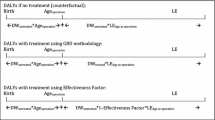Abstract
Background
The considerable number of surgical procedures performed each year, as well as the significant burden of surgical disease globally, have brought surgery into the arena of public health concerns. Several articles have shown the cost-effectiveness of surgical interventions in the developing world. The authors suggest that surgery has an important role in global public health, specifically through international volunteer surgical missions as a vehicle for delivery.
Methods
Eight Operation Smile medical missions from 2008 are analyzed using the disability-adjusted life year (DALY) framework and disability weights from the life tables of the first Disease Control Priorities Project (DCP1). The DCP1 life tables suggest that the entire burden of disease from a cleft lip and palate is incurred within the first 4 years of life. The same group of missions is analyzed using life tables modified by the authors to reflect the disability associated with cleft lip and palate that goes beyond the first 5 years of life.
Results
Using the DCP1 life tables, the cost per patient during the eight Operation Smile missions analyzed was $278 and $1827 with an average of $796. Using the life tables modified by the authors, the cost per patient was between $7.36 and $96.04 (average $33.94).
Conclusions
The absence of disability weights for untreated cleft lip and palate after the fifth year of life does not fit with the reality of living with an unrepaired cleft lip or palate. The authors conclude that secondary interventions alleviate disability and should enable an individual to approach a zero residual disability weight.
Similar content being viewed by others
References
World Health Organization (2006) Addressing the global challenges of craniofacial anomalies. Report of a WHO meeting on International Collaborative Research on Craniofacial Anomalies. Human Genetics Project. WHO, Geneva
Bickler SW (2008) Global surgery: defining a research agenda. Lancet 372:90–92
Debas HT, Gosselin R, McCord C et al (2006) Surgery. In: Jamison D, Brenan J, Measham A et al (eds) Disease control priorities in developing countries, 2nd edn. Oxford University Press, New York, pp 1245–1260
Anonymous (2008) Increasing access to surgical services in resource-constrained settings in Sub-Saharan Africa. Final report of the Bellagio essential surgery group meeting in Kampala, Uganda, July 22–24, 2008. Retrieved from: http://globalhealthsciences.ucsf.edu/bellagio/docs/essential_surgery_kampala_2008_report.pdf
Ozgediz D, Jamison D, Cherian M et al (2008) The burden of surgical conditions and access to surgical care in low- and middle-income countries. Bull World Health Organ 86:646–647
Ozgediz D, Riviello R (2008) The “other” neglected diseases in global public health: surgical conditions in Sub-Saharan Africa. PLoS Med 5(6):e121
Farmer PE, Kim JY (2008) Surgery and global health: A view from beyond the OR. World J Surg 32:533–536
Murray CJ (1994) Quantifying the burden of disease: the technical basis for disability adjusted life years. Bull World Health Organ 72:429–445
World Health Organization (2008) Country—Vietnam. Retrieved April 23, 2009 from: http://www.who.int/countries/vnm/en/
Central Intelligence Agency (2008) The world factbook: Vietnam. Updated April 9, 2008, Retrieved April 23, 2009 from: http://www.cia.gov/library/publications/the-world-factbook/geos/vm.html
McCord C, Chowdhury Q (2003) A cost effective small hospital in Bangladesh: what it can mean for emergency obstetric care. Int J Gynaecol Obstet 81:83–92
Gosselin TA, Thind A, Bellardinelli A (2006) Cost/DALY averted in a small hospital in Sierra Leone: what is the relative contribution of different services? World J Surg 30:505–511
Sherman R, Magee B (2009) International missions—cleft care. In: Losee J, Kischner R (eds) Comprehensive cleft care. McGraw-Hill, New York, pp 1029–1038
Jamison DT et al (eds) (1993) Disease control priorities in developing countries. Oxford University Press, New York
Harper DC, Peterson DB (2001) Children of the Philippines: attitudes toward visible physical impairment. Cleft Palate Craniofac J 38:566–576
Sell D (2008) Speech in the unoperated or late operated cleft lip and palate patient. In: Mars M, Sell D, Habel A (eds) Management of cleft lip and palate in the developing world. Wiley, Chichester, pp 179–192
World Health Organization (2006) Life tables for WHO member states. Retrieved April 23, 2009, from: http://www.who.int/whosis/database/life_tables/life_tables.cfm
Author information
Authors and Affiliations
Corresponding author
Rights and permissions
About this article
Cite this article
Magee, W.P., Vander Burg, R. & Hatcher, K.W. Cleft Lip and Palate as a Cost-effective Health Care Treatment in the Developing World. World J Surg 34, 420–427 (2010). https://doi.org/10.1007/s00268-009-0333-7
Published:
Issue Date:
DOI: https://doi.org/10.1007/s00268-009-0333-7




